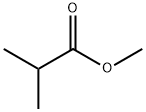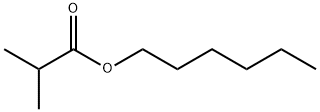Ethyl isobutyrate
Synonym(s):Ethyl 2-methylpropanoate
- CAS NO.:97-62-1
- Empirical Formula: C6H12O2
- Molecular Weight: 116.16
- MDL number: MFCD00009165
- EINECS: 202-595-4
- SAFETY DATA SHEET (SDS)
- Update Date: 2025-12-17 09:50:35

What is Ethyl isobutyrate?
Chemical properties
CLEAR COLOURLESS LIQUID
Chemical properties
Ethyl isobutyrate has a fruity aromatic odor.
Occurrence
Reported found in apple juice, banana, chocolate, cognac, Concord grape, honey, apricot, orange, pineapple, rum, strawberry, strawberry oil, watermelon, whiskey, champagne wine, grape wine, beer, port, passion fruit wine, sherry wine, orange juice, papaya, mango, kiwi fruit, quince, spineless monkey orange (Strychnos madagasc.), spearmint oil and Parmesan cheese.
The Uses of Ethyl isobutyrate
Ethyl Isobutyrate is a synthetic flavoring agent that is a stable, colorless liquid of dry, fruity odor. it should be stored in tin, glass, or resin-lined containers. it is used to give fruity effects to flavors for applications in candy, baked goods, and beverages at 10–100 ppm.
The Uses of Ethyl isobutyrate
It is employed to make flavoring compounds and essences, as a flavoring agent and to flavor animal feeds.
Definition
ChEBI: Ethyl isobutyrate is a fatty acid methyl ester obtained by the formal condensation of isobutyric acid with ethanol. It has a role as a metabolite. It is functionally related to an isobutyric acid.
Preparation
By esterification of ethanol with isobutyric acid under azeotropic conditions.
Aroma threshold values
Detection: 0.01 to 1 ppb
Taste threshold values
Taste characteristics at 12.5 ppm: pungent, ethereal and fruity with a rum- and eggnog-like nuance. Taste characteristics at 20 ppm: sweet, ethereal, fruity with a rum-like nuance
Synthesis Reference(s)
Tetrahedron, 27, p. 2671, 1971 DOI: 10.1016/S0040-4020(01)98056-1
Tetrahedron Letters, 28, p. 953, 1987 DOI: 10.1016/S0040-4039(00)95884-2
General Description
Ethyl isobutyrate appears as a colorless volatile liquid with a fruity, aromatic odor. Less dense than water and insoluble in water. Vapors heavier than air. May irritate skin and eyes. Used to make flavoring extracts and other chemicals.
Air & Water Reactions
Highly flammable. Insoluble in water.
Reactivity Profile
An ester. Esters react with acids to liberate heat along with alcohols and acids. Strong oxidizing acids may cause a vigorous reaction that is sufficiently exothermic to ignite the reaction products. Heat is also generated by the interaction of esters with caustic solutions. Flammable hydrogen is generated by mixing esters with alkali metals and hydrides.
Health Hazard
May cause toxic effects if inhaled or absorbed through skin. Inhalation or contact with material may irritate or burn skin and eyes. Fire will produce irritating, corrosive and/or toxic gases. Vapors may cause dizziness or suffocation. Runoff from fire control or dilution water may cause pollution.
Fire Hazard
HIGHLY FLAMMABLE: Will be easily ignited by heat, sparks or flames. Vapors may form explosive mixtures with air. Vapors may travel to source of ignition and flash back. Most vapors are heavier than air. They will spread along ground and collect in low or confined areas (sewers, basements, tanks). Vapor explosion hazard indoors, outdoors or in sewers. Runoff to sewer may create fire or explosion hazard. Containers may explode when heated. Many liquids are lighter than water.
Safety Profile
Moderately toxic by intraperitoneal route. A skin irritant. Flammable liquid. A very dangerous fire hazard when exposed to heat or flame; can react vigorously with oxidizing materials. To fight fire, use foam, CO2, dry chemical. When heated to decomposition it emits acrid smoke and irritating fumes. See also ESTERS.
Purification Methods
Wash the ester with aqueous 5% Na2CO3, then with saturated aqueous CaCl2. Dry it over CaSO4 and distil. [Beilstein 1 IV 846.]
Properties of Ethyl isobutyrate
| Melting point: | -88°C |
| Boiling point: | 112-113 °C (lit.) |
| Density | 0.865 g/mL at 25 °C (lit.) |
| vapor density | 4.01 (vs air) |
| vapor pressure | 40 mm Hg ( 33.8 °C) |
| refractive index | n |
| FEMA | 2428 | ETHYL ISOBUTYRATE |
| Flash point: | 57 °F |
| storage temp. | Flammables area |
| solubility | alcohol: miscible(lit.) |
| form | Liquid |
| color | Clear colorless |
| Odor | at 10.00 % in dipropylene glycol. sweet ethereal fruity alcoholic fusel rummy |
| Odor Threshold | 0.000022ppm |
| Water Solubility | Not miscible or difficult to mix in water. Soluble in alcohol. |
| JECFA Number | 186 |
| Merck | 14,3814 |
| BRN | 773846 |
| Stability: | Volatile |
| CAS DataBase Reference | 97-62-1(CAS DataBase Reference) |
| NIST Chemistry Reference | Propanoic acid, 2-methyl-, ethyl ester(97-62-1) |
| EPA Substance Registry System | Ethyl isobutyrate (97-62-1) |
Safety information for Ethyl isobutyrate
| Signal word | Danger |
| Pictogram(s) |
 Flame Flammables GHS02 |
| GHS Hazard Statements |
H225:Flammable liquids |
| Precautionary Statement Codes |
P210:Keep away from heat/sparks/open flames/hot surfaces. — No smoking. P370+P378:In case of fire: Use … for extinction. P403+P235:Store in a well-ventilated place. Keep cool. |
Computed Descriptors for Ethyl isobutyrate
Ethyl isobutyrate manufacturer
New Products
Indole Methyl Resin tert-butyl 9-methoxy-3-azaspiro[5.5]undecane-3-carboxylate Boc-His(Boc)-OH 2-CTC Resin 4-Chloro-7-tosy1-7Hpyrrolo[2,3-d]pyrimidine 5,7-Dibromo-1H-indole 2,5-dichloro-N-hydroxy-4,6-dimethylpyridine-3-carboximidamide 2,2-Dimethoxy-7-azaspiro[3.5]nonane hydrochloride 4-chloromethyl-5-methyl-1,3-dioxol-2-one (DMDO-Cl) R-2-BENZYLOXY PROPIONIC ACID 1,1’-CARBONYLDIIMIDAZOLE 1,1’-CARBONYLDI (1,2-4 TRIAZOLE) N-METHYL INDAZOLE-3-CARBOXYLIC ACID 4-((2-hydroxyethyl)thio)benzoic acid 1-(TERT-BUTOXYCARBONYL)-2-PYRROLIDINONE Methyl 6-methylnicotinate 3-Pyridineacrylic acid tert-Butyl carbazate TETRAHYDRO-2H-PYRAN-3-OL 2-((4-morpholinophenylamino) (methylthio) methylene) malononitrile 3-(4-morpholinophenylamino)-5-amino-1H-pyrazole-4-carbonitrile 2,4-dihydroxybenzaldehyde 1,3-Diethyl-1,3-Diphenylurea Methyl 2-methylquinoline-6-carboxylateRelated products of tetrahydrofuran








You may like
-
 Ethyl isobutyrate CAS 97-62-1View Details
Ethyl isobutyrate CAS 97-62-1View Details
97-62-1 -
 Ethyl Isobutyrate CAS 97-62-1View Details
Ethyl Isobutyrate CAS 97-62-1View Details
97-62-1 -
 Ethyl isobutyrate CAS 97-62-1View Details
Ethyl isobutyrate CAS 97-62-1View Details
97-62-1 -
 Ethyl IsobutyrateView Details
Ethyl IsobutyrateView Details
97-62-1 -
 Pyridine 99.5% HPLC /UV SpectroscopyView Details
Pyridine 99.5% HPLC /UV SpectroscopyView Details
110-86-1 -
 Dibutyl PhthalateView Details
Dibutyl PhthalateView Details
84-74-2 -
 Imidazole Spot supply, competitive priceView Details
Imidazole Spot supply, competitive priceView Details
288-32-4 -
 Thiourea 99% ARView Details
Thiourea 99% ARView Details
62-56-6
